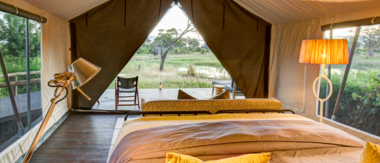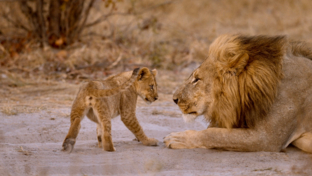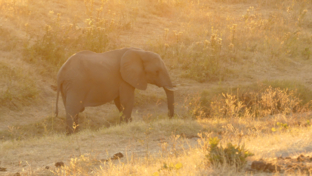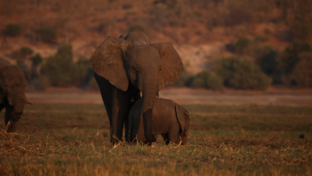Chobe National Park Safari: Botswana’s Wilderness Unveiled
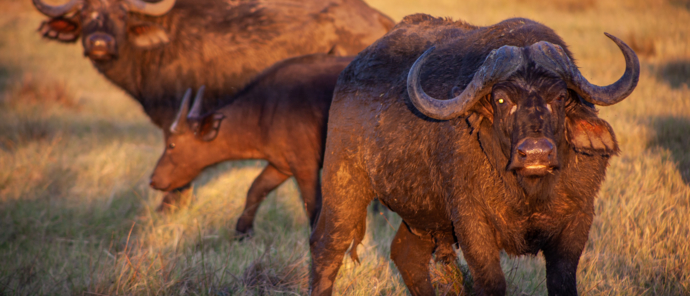
Welcome to Chobe National Park, one of Botswana’s most iconic safari destinations.
Set along the lush wildlife-rich banks of the Chobe River, this incredible Botswana safari destination has a perfect blend of untamed wildlife encounters and luxury safari accommodation.
A Chobe safari is your chance to experience Africa’s largest concentration of elephants and an incredible diversity of wildlife, including lions, leopards, buffalo, hippos, and over 450 bird species. A game drive in Chobe gives you front-row seats to some of Africa’s most awe-inspiring wildlife moments.
Alongside the spectacular wildlife experiences, Chobe offers a fusion of untamed wilderness and luxurious safari lodge accommodation at our Ngoma Safari Lodge. Immerse yourself in the wild Chobe wilderness while enjoying the comfort of a luxury safari lodge. Set out on guided game drives, glide along the Chobe River on a luxury boat cruise, and explore the bush on foot with unforgettable walking safaris.
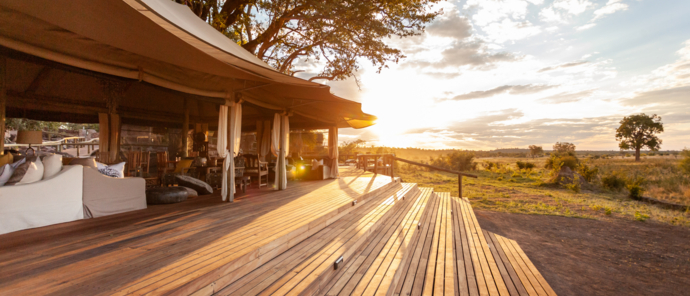
Where To Find Chobe National Park
Chobe National Park, Botswana’s first National Park, lies in the northeast region where the Chobe River forms the border with Zimbabwe, Namibia and Zambia.
Covering more than 11,700 km², the park is divided into four regions: Serondela, the Savuti Marsh, the Linyanti Marsh, and the hinterland, each offering something different to discover.
In the rainy season, vast floodplains blanket the landscape, then dry into sweeping grasslands that draw elephants, buffalo, and countless antelope.
The park’s varied biomes ensure that there is always something new and exciting to discover on a Chobe safari.
The Essence of A Chobe National Park Safari
On a Chobe National Park safari, you will explore wild landscapes and encounter abundant wildlife, with Machaba Safari’s expert guides by your side.
Chobe is renowned as a premier big game destination, where massive herds of elephant and buffalo roam freely across the unfenced wilderness. Explore the park and discover elusive leopards, powerful lion prides, and the hippos and crocodiles that rule the Chobe River. Home to more than 450 bird species, this vast park also welcomes flocks of migratory birds that transform its skies with the changing seasons.
Explore this diverse terrain on open-air 4x4 vehicles, serene boat cruises on the Chobe River and thrilling walking safaris through the wilderness.
Sip sundowners while watching elephants splash in the vast floodplains of Chobe or track lions on foot with your expert safari guide. The possibilities are endless on a safari adventure in Chobe National Park.
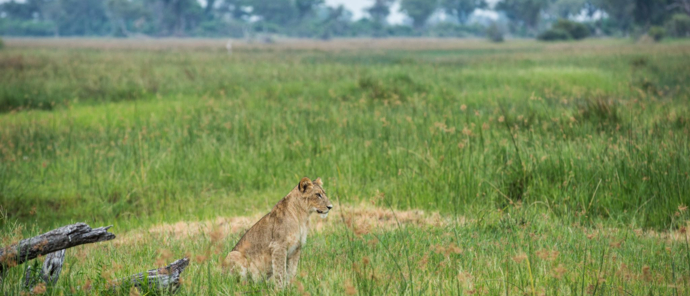
Chobe National Park Safaris: The Seasons
Chobe National Park has two distinct seasons: wet and dry. Each one shapes a very different, yet equally magical, safari experience.
From October to March, Southern Africa’s summer brings the wet season, a time of vibrant greenery and plentiful water from heavy rains. The dry season, from April to September, is Southern Africa’s winter and an exceptional time for wildlife viewing. With little rain, animals gather in huge numbers around the last remaining water sources.
How The Seasons Affect The Chobe Safari Experience
The magic of Chobe National Park lies in its different seasons, each one offering a unique and unforgettable safari experience.
During the wet or rainy season (October to March), the landscape transforms into a lush, green oasis with floodplains expanding like a lake, perfect for a boat cruise on the Chobe River. Wildlife spreads out during this time, so sightings take a little more effort, but the abundance of new births brings a sense of renewed magic, creating an unmatched safari experience.
In the dry months (April to September), the lack of rain thins out the vegetation, turning it brown and rusty-coloured. With few water sources, animals begin to gather in huge numbers around the last remaining waterholes, which makes spotting wildlife on a 4x4 safari drive in Chobe easier.
Chobe National Park Safaris: May to September - Dry Season
Between April and September, or what is known as the Dry Season, is when Chobe National Park truly shows off its treasures. As water becomes scarce, the wildlife starts flocking to the banks of the Chobe River. Super herds of elephants, buffalo and antelopes gather in thousands to feed on the lush vegetation growing nearby.
In a place teeming with wildlife, expect to see lions basking lazily in the open and leopards stalking their next easy meal. The concentration of wildlife, combined with bright, clear days, makes game drives during the dry season unbeatable for spotting animals.
Chobe - Safari Times - Dry Season
In the dry season, the Chobe safari experience has some of the best wildlife viewing in Africa. Attracted to the Chobe River, the animals gather in large numbers, creating amazing opportunities for game drive sightings.
The safaris in Chobe can differ greatly depending on the time of day and the type of safari activity. Safari experiences range from serene river cruises on the Chobe River and thrilling 4x4 game drives to unforgettable walking safaris.
Chobe - Early Morning Safaris - Dry Season
Chobe’s dry season morning safaris usually begin around 05:30 to 06:00. This is when the air is cool and predators like lions and leopards are still active. The Chobe River is shrouded in mist, and it mirrors the beautiful sunrise colours. It makes for a surreal backdrop for your morning coffee stop during the game drive.
Chobe - Mid-Day Safaris - Dry Season
The mid-day safari during the dry season in Chobe National Park gives you a unique chance to explore the area by boat. During the warmest part of the day, between 11:00 and 14:00, animals gather on the banks of the river to escape the heat, creating ideal conditions for a relaxing boat cruise on the Chobe River. Watch as hippos wallow and crocodiles bask on the sunny banks while elephants and antelope cool down and have a drink. There is a slower pace to these river cruises, which is great for taking wildlife photos.
Chobe - Afternoon/Sunset Safaris - Dry Season
From 15:30 to 18:30, during the sunset safari at Chobe National Park, the landscape comes alive in the warm light of the afternoon sun. As the temperatures start to cool, the wildlife becomes active once again. Predators, such as lions and leopards, prepare for their busy night of searching for prey.
Enjoy breathtaking scenery and brilliant sunsets for unforgettable sundowners, in the presence of Chobe’s abundant wildlife during a sunset 4x4 drive or boat cruise on the Chobe River
Chobe - Night Safaris - Dry Season
The hidden world of Chobe National Park awakens as the sun sets. As dusk settles over Chobe at around 18:30, a night safari game drive reveals a secret world of wildlife rarely glimpsed in the light of day.
Spot hyenas and leopards on the prowl, owls and small mammals like genets hiding in the trees, and other nocturnal animals as they become more active.
Skilled guides use spotlights to track and find wildlife in the dark. Every rustle of leaves and reflection of glowing eyes is a sign of something exciting to be seen. Listen to epic tales about the stars and constellations in the African sky while stargazing with your guide. The more secretive side of Chobe National Park is waiting to be discovered on a game drive at night.
Chobe: Weather and Climate in Dry Season
Chobe’s dry season creates ideal weather conditions for unforgettable safari experiences. The mornings are usually cool and crisp with temperatures around 10°C (50°F), making the sunrise game drives in Chobe particularly invigorating. As the day warms up towards the afternoon, temperatures hover around a pleasant and comfortable 25 - 30°C (77 – 86°F), perfect for long safari adventures and wonderful sightings. With almost no rainfall forecast during this time of year, you can look forward to clear sunny skies and uninterrupted game viewing.
Things to keep in mind during the Dry Season in Chobe
What to Wear on a Dry Season Chobe Safari
For a safari in the dry season at Chobe National Park, dress in layers to stay warm on the cool mornings and comfortable when the afternoons heat up. To blend in with the natural surroundings of the Chobe wilderness, pick neutral colours such as khaki or olive green and avoid bright colours.
Long-sleeve tops and pants go a long way to protecting your skin from the harsh African sun and inquisitive insects hoping for a nibble. Remember to pack your wide-brimmed hat, sunglasses and sunscreen for extra protection. Closed, comfortable shoes are recommended for game drives and walking safaris.
Photography Tips for a Chobe Dry Season Safari
Some of the best conditions for wildlife photography on safari at Chobe National Park are during the dry season. This time of year, you will enjoy the sight of clear skies, golden light and wildlife in incredible numbers gathering around water sources.
The soft morning and afternoon light is perfect for getting dramatic shots of the scenery and wildlife. Bring along a zoom lens, ideally 100 - 400mm, for close-up shots that don't disturb wildlife. Dust is an inevitability during a dry season safari, so make sure to bring along dust covers for your equipment.
With the right camera equipment as well as perfect light conditions and thrilling wildlife sightings, Chobe can deliver incredible photo opportunities.
Spotting Animals in the Dry Season
Wildlife encounters in Chobe National Park take on a unique character during the dry season, unlike any other time of year. Between April and September, when Chobe is at its driest, wildlife gathers around the last remaining rivers and waterholes. Here, they form large herds and are easy to spot from a 4x4 game viewing vehicle.
The vegetation is very sparse because of the lack of rain, which leads to clearer and unobstructed views of the landscape and any hidden wildlife. If you love photography, you will be rewarded with plenty of photo opportunities.
The dry season is tough on wildlife, so few young are born, and sightings of newborns are uncommon.
The Landscape of Chobe in the Dry Season
During Chobe’s dry season, the landscape is transformed into a patchwork of dusty plains and barren bushveld.
With water levels receding, the clay bottom of the riverbeds dries up and cracks. Most of the greenery is limited to the surviving riverbanks that draw in the wildlife. Further from the rivers, the landscape is covered with barren trees and dry golden grasses, creating a dramatic scenery that makes spotting animals on safari in Chobe much easier as they move across the open plains.
Why the Dry Season is Prime for Game Viewing in Chobe
When water is scarce during the dry season in Chobe National Park, it brings wildlife together in ways that make every safari moment unforgettable.
As the park's waterholes dry up, animals flock to the Chobe River and remaining water sources, creating spectacular wildlife gatherings. With very little food and water to sustain them, the animals tend to stick to regular patterns of movement between water sources. This activity increases the chance of wildlife encounters while on safari in Chobe.
All these factors result in the dry season in Chobe being one of the most reliable and dramatic times of the year for game viewing.
Health and Safety Tips for a Dry Season Safari in Chobe
When it comes to health and safety during the dry season in Chobe National Park, guests should carry plenty of drinking water to stay hydrated. As always, apply sunscreen and wear a hat to protect yourself from the sun. Although there are fewer insects at this time of year, it is still a good idea to have insect repellent, especially when near water sources.
For your safety as well as the animals that you are viewing, always follow your guide's instructions. Keep a respectful distance from all wildlife, remain as quiet as possible during sightings and never leave the vehicle or designated paths without permission.
Time Schedules For Chobe Safaris During Dry Season
A typical dry season safari in Chobe is perfectly timed to showcase the landscape and its wildlife at their most captivating.
Here is what a typical day of safari looks like during Chobe’s dry season:
- Morning (05:00 - 9:30): The best time to encounter predators on the move while the temperature is cool.
- Midday (12:00 - 14:00): Ideal time for a boat cruise along the Chobe River to pass the hottest time of the day.
- Afternoon (15:00 - 18:30): Perfect time to watch elephants drinking and playing at the river while you enjoy a sundowner.
Animals to expect to see on safari at Chobe in Dry Season
During the dry season, between April and September, a Chobe National Park safari offers some of the best wildlife encounters in Africa. As the water dries up, animals gather in huge numbers along the Chobe River. Which makes for easier and more frequent wildlife sightings while on a safari.
Each day, the elephants of Chobe gather in massive herds to drink, bathe, and play along the riverbank. It's magical moments like these that make Machaba safaris unforgettable.
Thanks to the cooler temperatures, predators like lions and leopards are more active and easier to spot as they patrol the riverbanks and waterholes where their prey are gathered. It is common to spot hippos wallowing in the water and crocodiles basking on the river banks, along with a rich variety of birds, including African fish eagles, striped kingfisher and lilac-breasted rollers.
The open landscape is also a blank canvas for seeing large herds of buffalo, groups of zebra, impala, kudu, sable antelope, and roan antelope that are more elusive during the wet season.
These hotspots of wildlife action offer raw and untamed safari moments.
Chobe National Park Safaris: October to April - Wet Season
The wet season, also known as the green season, in Chobe National Park is a time of new beginnings.
From October to May, the rains transform the parched landscape into a lush, green paradise for the wildlife. A Chobe safari during this time is a vibrant and refreshing experience with loads of wildlife activity. Many of the antelope choose this time of year to give birth, as there is plenty of vegetation for food and cover. Young impalas are commonly seen on the open plains during a 4x4 game drive, often drawing predators and adding to the excitement.
Birdwatching in Chobe is incredible as migratory birds that have spent the winter in the North return. These birds are incredible to see as they flock to Chobe each year, attracting birdwatching enthusiasts from all over.
Making the season even more unique is the distinct smell in the air after each rainfall. As simple as it is, it is one of the special things about Chobe that keeps people coming back.
Chobe - Safari Times - Wet Season
The lush and renewed landscape during the wet season at Chobe National Park gives you a wonderfully varied safari experience shaped by the dramatic changes to the landscape. Visitors who want an unforgettable safari experience can explore the park through 4x4 game drives, river cruises on the Chobe River and thrilling night safaris.
With water in abundance, the animals tend to be a bit more spread out, leading to unpredictable but sometimes more rewarding sightings. This time of year, many animals give birth, and it is common to stumble across elephant calves, lion cubs and young antelope. Birdlife is at its best during the wet season with the return of migratory species that add a vibrancy to the bird population.
The fresh and revitalised landscape of Chobe gives every safari here the chance of thrilling encounters amongst the dramatic and lush surroundings.
Typical Time Schedules For Chobe Safaris During Wet Season
During the wet season, planning the day to avoid high afternoon temperatures and afternoon thunderstorms is important.
Here is what a typical day in Chobe during the wet season looks like:
- Morning (05:30 - 09:00): Beat the heat and rain with an early start
- Midday (12:00 - 14:00): The perfect time of day to enjoy a boat cruise on the Chobe River and expansive floodplain
- Afternoon (16:00 - 19:00): Post-rain drives reveal refreshed wildlife
Chobe - Early Morning Safaris - Wet Season
An early morning safari in Chobe National Park during Botswana’s wet season provides guests with one of the most rewarding wildlife experiences. Usually starting at around 05:30 each morning, the dawn game drives in Chobe provide cool and often misty weather perfect for spotting predators like lions, leopards and wild dogs. Abundant birdlife is ever-present in the cool mornings, creating an incredible soundtrack for a morning safari.
The lush green vegetation provides ideal cover during the birthing season, giving young animals a safe place to hide. For safari enthusiasts who would like to experience the best time for a luxury Chobe safari, an early morning game drive is the ultimate time for unparalleled beauty and thrilling wildlife encounters.
Chobe - Mid-Day Safaris - Wet Season
A midday safari in Chobe National Park during the wet season provides travellers with an authentic Botswana experience and the opportunity to witness incredible wildlife in stunning, wild environments.
Usually between 11:00 and 14:00, a midday safari is ideal for a slower-paced scenic Chobe River safari cruise. The river swells this time of year, meaning you can travel even deeper into areas usually unreachable and experience wildlife encounters that you couldn't see on a game viewer. Get close-up views of hippos, and enjoy the sight of elephants swimming and crocodiles wallowing on the banks. The migratory birdlife makes for an incredible birding safari in Botswana during this time.
Chobe - Afternoon/Sunset Safaris - Wet Season
There is a true magic to the afternoon and sunset safari in Chobe National Park during the wet season. Soft light, lush landscapes and incredible wildlife sightings make for an unforgettable Botswana safari experience.
More animals, especially antelope, can be seen with their young as they have a last feed in the open plains, as the day begins to cool from between 15:30 and 18:30. Predators start to become active as the temperature drops and dusk approaches.
Softer light contrasts sharply with incredible shades of green vegetation, setting a scene perfect for wildlife photography in Chobe. The dramatic skyline, active wildlife and a perfect sundowner spot are what make a luxury sunset safari in Botswana unforgettable.
Chobe - Night Safaris - Wet Season
The mysterious and untamed world of a night safari in Chobe National Park is one full of excitement and thrills. Once the sun sets, your experienced Machaba guide will use a spotlight to search for the nocturnal animals. Look out for leopards in trees, hyenas searching for prey and our favourite nocturnal birds, the owls, that swoop silently from tree to tree, giving the occasional hoot.
There is no end to the possibilities of what wildlife you will encounter on a night safari in Botswana.
Chobe: Weather and Climate in Wet Season
The wet season, usually between November and April, brings a dramatic change to the landscape and the Chobe National Park safari experience. If you're planning a Chobe safari during this time, it is essential to understand the weather patterns so you can make the most of your time here.
Chobe during the wet season can be very hot and humid, with temperatures during the day reaching between 30°C and 35°C (86°F to 95°F). Humidity increases later in the day, especially just before the first afternoon rain arrives. Rainfall usually comes in short but heavy thunderstorms and can be so predictable at times that our guides can time when the rains will arrive.
These rains transform the landscape into a lush, green oasis brimming with life. It's part of the reason why this season is an incredible time of year for a Chobe safari experience.
Things to Keep in Mind During the Wet Season in Chobe
Here are a few tips to help you plan your safari at Chobe in the wet season:
What to Wear on a Wet Season Chobe Safari
The weather during the wet season in Chobe can be hot and humid, and interspersed with short and heavy rainstorms. For the most comfortable Botswana safari during this time, wear light and breathable clothing that can air dry quickly. Choose natural shades like khaki and olive green to blend into the landscape.
A lightweight waterproof or water-resistant jacket is essential for those afternoon downpours. Shoes should be sturdy and waterproof, ideal for wet and muddy ground. There is a higher level of mosquito activity on a Chobe Safari in the wet season, so bring along insect repellent and wear long-sleeve tops and full-length pants to protect your arms and legs. Remember to bring your sunscreen, a wide-brimmed hat and sunglasses for sun protection during Botswana's hot season.
With the right gear, you will be prepared and comfortable on your luxury Botswana safari in the wet season.
Photography Tips for a Chobe Wet Season Safari
Photography on safari in Chobe National Park during the wet season has its own challenges, but gives travellers immeasurable rewards.
The wet season, between November and March in Botswana’s Chobe National Park, is one of transformation. One where the dry landscape gives way to lush green vegetation, dramatic skies and incredible wildlife encounters. The perfect ingredients for excellent safari photography.
These wet conditions, however require extra care for your gear. Sudden downpours and high humidity can damage electronics. Make sure to bring rain covers, dry bags and silica gel to protect your equipment. A microfibre cloth is extremely handy for clearing the lens of rain or fogging.
This season brings amazing wildlife encounters, especially around water. Plenty of young animals are active, so bring your zoom lens to capture the adorable moments from a safe distance.
Spotting Animals in the Wet Season
The game viewing and animal spotting experience on safari at Chobe National Park during the wet season can be very rewarding. The lush green vegetation and plentiful water mean animals are a bit more spread out. The abundance of food and water leads to active predators and lots of antelope and other species.
As this is the main birthing season, it is common to see plenty of young animals that bring an instant joy to any sighting. Watch as lion cubs play amongst their pride, young impala stay close to their herd and baby elephants start learning to use their trunks.
With the bush at its densest, spotting wildlife becomes a challenge, but it also makes every sighting feel even more thrilling and rare.
The Landscape of Chobe in the Wet Season
For a safari in Botswana, nothing beats the landscape of Chobe National Park during the wet season. The rains have transformed the park into a lush ecosystem full of green and thriving vegetation. Scattered amongst the vibrant and dense vegetation are a myriad of waterholes and rivers that attract an abundance of wildlife and migratory birds.
Things to Keep in Mind During Early Morning Safaris in the Wet Season in Chobe
When embarking on an early morning safari in Chobe National Park, keep in mind that although it can get humid and hot later, the morning can be quite cool and wet. Wear light, quick-drying layers and make sure to have a warm rain jacket to keep you warm and dry. Waterproof hiking boots add a layer of comfort and protection for walking safaris in Chobe during the wet season, and are something you can't do without.
Health and Safety Tips for a Wet Season Safari in Chobe
Your safari in Chobe during the wet season has its own set of health and safety tips to keep in mind. Remember to stay hydrated, apply sunscreen and wear a wide-brimmed hat, as the days can get very hot and humid. The wet season also brings a high level of mosquito activity, so pack plenty of insect repellent and wear long-sleeved tops and full-length pants to protect your arms and legs from bites.
For your safety and the well-being of the animals, always follow your guide’s instructions. Always keep a safe, respectful distance, and stay as quiet as possible during wildlife sightings.
Animals to expect to see on safari at Chobe in the Wet Season
A safari in Chobe National Park during the wet season offers especially vibrant and exciting wildlife encounters. During the wet season, lush vegetation and plentiful water may scatter the animals, but the action is more thrilling than ever.
For those who love birding safaris in Chobe, the birdlife is incomparable as flocks of migratory birds return to Chobe, ready to breed and show off their most striking plumage. The treetops and riverbanks are alive with colour and birdsong.
Antelope species, such as impala and kudu, are entering their birthing season, so the sight of newborn calves is not uncommon. This abundance of young animals means the predators of Chobe are active and in search of any vulnerable young.
One of the best times for a Chobe elephant safari is during the wet season. The elephants come from far and wide to the Chobe River, and the large herds famous in Chobe enjoy feeding on the lush green vegetation along the riverbanks.
While spotting predators usually takes a bit of patience, the reward of seeing them against the vibrant backdrop of the landscape is what makes this time of year for safari so thrilling. They are more active with the abundance of water, and catching a glimpse of them stalking young animals is an unforgettable experience.
Chobe National Park Safari - Tips for Planning Your Adventure
Make the most of your Botswana Safari experience in Chobe with these tips:
- Best Time to Visit: All year round! Both seasons have something special that sets them apart. The dry season is best for game viewing and predator action. The wet season is the ideal time for enjoying the beauty of the park, spotting migratory birds and for photography.
- What to Pack: Bring binoculars for birding, neutral-coloured clothing for blending in, sunscreen and insect repellent, and a raincoat for those sudden downpours.
- Booking Your Safari: It's always best to book your stay well in advance. Ngoma Safari Lodge in Chobe is one of our most popular lodges for its unmatched luxury and exciting wildlife experiences.
Planning your safari by the season ensures you can make the most of Chobe’s exceptional safari experience.
The Ultimate Chobe National Park Safari
Your safari into Chobe National Park is an immersion into one of Africa’s oldest and greatest wilderness areas.
Great herds of elephants move through the park, predators stalk their prey and deliver thrilling and untamed encounters and the landscape is a mosaic of lush grassland plains and dense woodlands that are intertwined by the beauty of the Chobe River.
At our Ngoma Safari Lodge, you can experience this untamed natural beauty in luxury and comfort. Perched above the Chobe floodplain, the lodge has panoramic views of the landscape and direct access to the park's raw and untamed wilderness. Ngoma Safari Lodge offers world-class hospitality, luxurious accommodation, gourmet meals and some of the most thrilling safari experiences from 4x4 game drives to boat cruises on the Chobe River.
Your stay at Ngoma Safari Lodge is designed to bring you closer to nature while enjoying the comfort and luxuries of a world-class lodge.
Luxury meets the wild heart of Botswana on a safari in Chobe National Park.
Book your Chobe safari today and step into a world where nature reigns supreme, framed by the elegance of Botswana’s finest lodges. This is the ultimate Chobe National Park safari.
Want to learn more about the Safari Experience?
